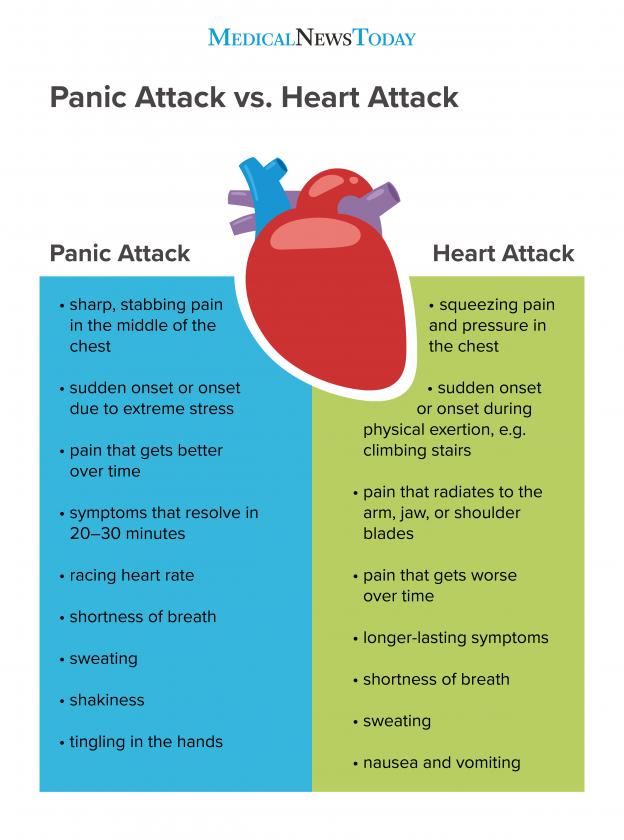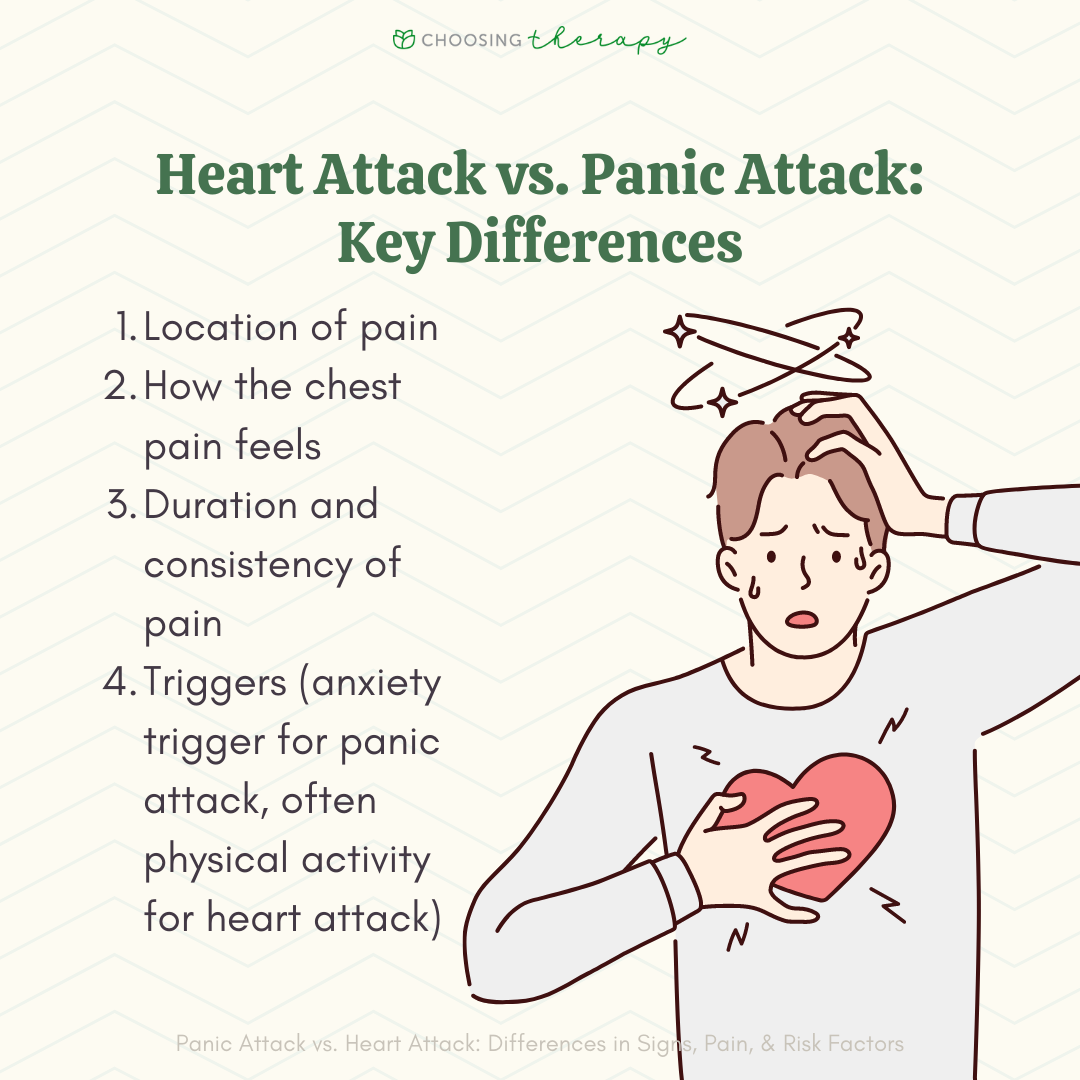Panic Attack Vs. Heart Attack: Key Differences Explained
Are you experiencing chest pain, shortness of breath, and a racing heart? Understanding the crucial distinction between a panic attack and a heart attack could save your life.
The symptoms of a panic attack and a heart attack can be alarmingly similar, leading to confusion and potentially delaying necessary medical intervention. Both can manifest with chest discomfort, dizziness, and feelings of impending doom. However, the underlying causes, the specific symptoms, and the appropriate courses of action differ significantly. This article will delve into these critical differences, providing clear guidance on how to distinguish between these two potentially life-threatening conditions and when to seek immediate medical assistance.
Panic attacks, often described as sudden surges of intense fear, are a common occurrence, affecting millions of people worldwide. They are characterized by a constellation of physical and psychological symptoms that can feel overwhelmingly real. A heart attack, on the other hand, is a medical emergency resulting from a blockage in the arteries supplying blood to the heart. The implications of misinterpreting these conditions can be severe, highlighting the need for accurate identification and rapid response.
Let's first consider the characteristics of a panic attack. These episodes typically strike without warning, though they can be triggered by stress, certain phobias, or underlying anxiety disorders. The hallmark of a panic attack is a feeling of intense fear, often accompanied by a sense of detachment from reality or one's body (depersonalization or derealization). Physical symptoms can include:
- Rapid heart rate (palpitations)
- Chest pain or discomfort
- Shortness of breath or feeling smothered
- Dizziness, lightheadedness, or feeling faint
- Sweating
- Trembling or shaking
- Nausea or abdominal distress
- Chills or hot flushes
- Numbness or tingling sensations (paresthesia)
- Fear of losing control or going crazy
- Fear of dying
These symptoms typically peak within minutes and subside within 20-30 minutes, although some individuals may experience lingering after-effects. Importantly, panic attacks are not directly caused by a physical problem with the heart. They are primarily a manifestation of the body's "fight or flight" response, triggered by the brain's misinterpretation of perceived danger, whether real or imagined.
Now, let's turn our attention to heart attacks, a far more serious and potentially fatal condition. A heart attack, or myocardial infarction, occurs when blood flow to a part of the heart muscle is blocked, usually by a blood clot. This blockage prevents the heart muscle from receiving oxygen, leading to tissue damage and, if left untreated, death. The symptoms of a heart attack can vary, but some common indicators include:
- Chest pain or discomfort, often described as pressure, squeezing, tightness, or fullness. This pain may radiate to the arm (usually the left arm, but can be either), jaw, neck, back, or stomach.
- Shortness of breath
- Cold sweats
- Nausea or vomiting
- Dizziness or lightheadedness
- Fatigue
Unlike panic attacks, heart attack symptoms may not always come on suddenly and can sometimes fluctuate. The pain associated with a heart attack may last for several minutes or longer, unlike the relatively brief duration of a panic attack. Women, in particular, may experience atypical symptoms, such as fatigue, nausea, and jaw pain.
The location of the pain can offer clues. Chest pain during a heart attack is typically centered in the chest and can feel like a crushing weight or a band of tightness. The pain from a panic attack is less likely to be localized, and may feel sharp or stabbing.
Another key difference is the context in which the symptoms arise. Panic attacks often occur during periods of stress or anxiety, or even seemingly at random. Heart attacks, however, are often precipitated by physical exertion, emotional stress, or occur in individuals with known risk factors for heart disease, such as high blood pressure, high cholesterol, smoking, diabetes, and a family history of heart disease.
The presence of certain risk factors can significantly increase the likelihood of a heart attack. These factors include age (men over 45 and women over 55), family history of heart disease, smoking, high blood pressure, high cholesterol, diabetes, obesity, and a sedentary lifestyle. While these risk factors don't definitively diagnose a heart attack, they raise suspicion and warrant prompt medical evaluation.
The duration and intensity of the symptoms are also crucial distinctions. Panic attacks tend to peak quickly and resolve within a relatively short time frame. Chest pain is a symptom, and with a heart attack, the pain is a more constant and persistent presence, although it can sometimes wax and wane. If chest pain persists for more than a few minutes, its essential to seek immediate medical attention. With a heart attack, any delay in treatment can lead to severe damage to the heart muscle and potentially result in death.
When evaluating the symptoms, consider the impact on daily activities. Panic attacks can be frightening, but they typically do not impair the ability to function. Heart attacks, on the other hand, often result in a significant decline in the ability to function, accompanied by weakness and fatigue.
The psychological aspects also differ. Panic attacks are often accompanied by intense fear, worry, and a sense of impending doom. Heart attacks, while also capable of causing anxiety, are less likely to be dominated by fear and are more closely related to physical distress. The focus of a person experiencing a heart attack is often on the physical pain and discomfort.
Furthermore, understand that the management of panic attacks and heart attacks differs significantly. Panic attacks are often managed with cognitive-behavioral therapy (CBT), medication (such as selective serotonin reuptake inhibitors, or SSRIs), and lifestyle modifications, such as regular exercise, relaxation techniques, and stress management. A heart attack requires immediate medical intervention, which may include medications to dissolve blood clots (thrombolytics), procedures to open blocked arteries (angioplasty or stent placement), and, in severe cases, surgery (coronary artery bypass grafting, or CABG). Delaying treatment during a heart attack can be catastrophic.
Given the overlap in symptoms, it is essential to seek medical advice when you are unsure of the cause of your symptoms. If you experience chest pain, shortness of breath, or other concerning symptoms, especially if you have any risk factors for heart disease, call emergency services immediately. A healthcare professional can conduct a thorough evaluation, including a physical examination, an electrocardiogram (ECG or EKG), and blood tests to determine the underlying cause.
An electrocardiogram (ECG or EKG) is a painless test that measures the electrical activity of the heart. An ECG can often detect signs of a heart attack, such as changes in the heart's electrical rhythm or evidence of damage to the heart muscle. Blood tests can also be used to detect specific proteins released by the heart muscle when it is damaged, helping to confirm a heart attack diagnosis.
Beyond the immediate medical interventions, preventive measures are important for both panic attacks and heart attacks. Managing stress through exercise, yoga, meditation, and other relaxation techniques can help to reduce the frequency and severity of panic attacks. Lifestyle changes, such as quitting smoking, eating a healthy diet, maintaining a healthy weight, and engaging in regular physical activity, can help reduce the risk of a heart attack.
Understanding your individual risk factors for heart disease is an essential step in prevention. Talk to your doctor about your family history, lifestyle, and any existing health conditions. Regular check-ups, including blood pressure and cholesterol screenings, can help identify and address potential problems before they lead to a heart attack. Consider a stress test if you are experiencing chest pain or have risk factors.
Panic attacks and heart attacks, while sharing some overlapping symptoms, are distinct conditions with different causes, symptoms, and treatments. Recognizing the key differences is crucial for getting the right medical attention in a timely manner. If you are unsure whether you are experiencing a panic attack or a heart attack, err on the side of caution and seek immediate medical attention. Your health and well-being depend on it.
In conclusion, a vital lesson is to prioritize your health. If you experience symptoms that are concerning, do not hesitate to seek professional medical help. Prompt action in the case of a suspected heart attack can save a life, while accurate diagnosis and treatment for panic attacks can significantly improve quality of life.
Remember that this information is intended for general knowledge and should not be considered medical advice. Always consult with a qualified healthcare professional for any health concerns or before making any decisions related to your health or treatment.


